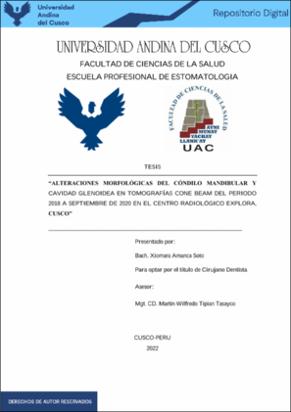| dc.contributor.advisor | Tipian Tasayco, Martin Wilfredo | |
| dc.contributor.author | Amanca Soto, Xiomara | |
| dc.date.accessioned | 2022-08-26T20:23:41Z | |
| dc.date.available | 2022-08-26T20:23:41Z | |
| dc.date.issued | 2022-03-08 | |
| dc.identifier.uri | https://hdl.handle.net/20.500.12557/4816 | |
| dc.description.abstract | El objetivo del presente estudio fue identificar las alteraciones morfológicas del cóndilo
mandibular y cavidad glenoidea en tomografías Cone Beam. Materiales y método: este
estudio es descriptivo de tipo observacional y corte transversal. La muestra estuvo
constituida por 80 tomografías de pacientes de ambos sexos de 21 años a más. Se evaluó
la morfología de las articulaciones temporomandibulares derecha e izquierda
independientemente. Los datos obtenidos fueron analizados mediante el programa SPSS.
Resultados: se encontró que el 77.5% de las tomografías en estudio presentaron al
menos alguna alteración en la ATM. La alteración condilar más frecuente fue el
facetamiento con 35% y la menos frecuente fue el cuerpo articular libre. Con respecto a
la cavidad glenoidea, la erosión superficial fue la más común con 17.5%. Conclusión: se
concluyó que las alteraciones morfológicas de la articulación temporomandibular están
relacionadas la edad, puesto que a mayor edad se encontró mayor porcentaje de
alteraciones en comparación con pacientes jóvenes. Y en referencia al sexo, se observó
una mayor prevalencia de alteraciones en el sexo femenino. | es_PE |
| dc.description.abstract | Objective: The aim of this study was to identify morphological alterations of the
mandibular condyle and glenoid cavity in Cone Beam tomography. Material
and method: this is a descriptive, observational and cross-sectional study. The sample
consisted of 80 CT scans of patients of both genders aged 21 years and older. The
morphology of the right and left temporomandibular joints was evaluated independently.
The data obtained were analyzed using SPSS software. Results: it was found that 77.5%
of the CT scans under study presented at least some alteration in the TMJ. The most
frequent condylar alteration was flattening with 35% and the least frequent was the free
articular body. Regarding the glenoid cavity, surface erosion was the most common with
17.5%. Conclusion: it was concluded that the morphological alterations of the
temporomandibular joint are related to age, since the higher the age, a higher percentage
of alterations was found in comparison with young patients. And in reference to gender,
there is a higher prevalence of alterations in the female gender. | en_US |
| dc.format | application/pdf | es_PE |
| dc.language.iso | spa | es_PE |
| dc.publisher | Universidad Andina del Cusco | es_PE |
| dc.rights | info:eu-repo/semantics/restrictedAccess | es_PE |
| dc.rights.uri | https://creativecommons.org/licenses/by-nc-nd/4.0/ | es_PE |
| dc.subject | Articulación temporomandibular | es_PE |
| dc.subject | Tomografía computarizada | es_PE |
| dc.subject | Alteraciones | es_PE |
| dc.title | Alteraciones morfológicas del cóndilo mandibular y cavidad glenoidea en tomografías Cone Beam del periodo 2018 a septiembre de 2020 en el Centro Radiológico Explora, Cusco | es_PE |
| dc.type | info:eu-repo/semantics/bachelorThesis | es_PE |
| thesis.degree.name | Cirujana Dentista | es_PE |
| thesis.degree.grantor | Universidad Andina del Cusco. Facultad de Ciencias de la Salud | es_PE |
| thesis.degree.discipline | Estomatología | es_PE |
| dc.publisher.country | PE | es_PE |
| dc.subject.ocde | https://purl.org/pe-repo/ocde/ford#3.02.14 | es_PE |
| renati.advisor.dni | 21521686 | |
| renati.author.dni | 72463099 | |
| renati.discipline | 911016 | es_PE |
| renati.juror | Arenas Fernández Dávila, Jesús Alejandro | |
| renati.juror | Vera Ferchau, Helga | |
| renati.juror | Gutierrez Acuña, Yeni | |
| renati.juror | Quispe Chauca, Jorge Luis | |
| renati.level | https://purl.org/pe-repo/renati/level#tituloProfesional | es_PE |
| renati.type | https://purl.org/pe-repo/renati/type#tesis | es_PE |



